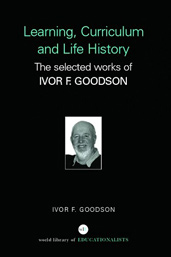Learning, Curriculum and Life Politics: the selected works of Ivor F. Goodson
Long Waves of Educational Reform
Bradford is a medium-sized industrial city located in the northeast United States. Like much of North America, the 1960s saw a range of new social policies and initiatives, which sought to broaden social class and racial inclusion. The pattern of racial composition changed drastically in these years. Bradford School District records indicate the percentage of ‘minority’ students as follows: 10.4 per cent in 1966, 14 per cent in 1968, 23.7 per cent in 1969. By 1989, the district’s pupil population was 62 per cent Afro-American and 18 per cent Hispanic. Social class patterns reflected a growing pattern of poverty in the urban core of the district. By 1985, 40 per cent of Bradford pupils lived in poverty.
In Bradford, a range of educational reforms was under way in the 1960s. In 1969, a small group of teachers at Livingston High School started to meet to discuss the deleterious impact of traditional grammars of schooling on teaching and learning. These teachers, witness to violent school riots at Livingston, believed that many of the problems of the school could be traced to the traditional structure of schooling with its isolated teachers and classrooms. Inspired by such leaders of the alternative school movement as Ivan Illich and John Holt, these teachers wanted to break down the artificial walls of classroom life and develop new learning patterns and environments so that students would learn how to become independent learners, by pursuing issues and topics of their own interest in real-life settings throughout the community, and by making decisions with staff on how to develop and run their school.
Therefore, a plan for an alternative school, Durants School, was developed and submitted as a proposal to the Bradford Board of Education in January 1971. The Board voted its approval and appointed David Henry, a charismatic and gifted teacher, at Livingston and instigator of the plan, as Principal. Henry assembled a staff of ten teachers – all young and innovative, keen to experiment and pioneer – virtually all in their 20’s and 30’s. The school was ‘without walls’: an office for Henry and his secretary, a couple of rooms, and a central meeting place for the whole school community in a converted warehouse. Classes – not organized in grade level – took place throughout the city, including ‘architecture’, with a local architect at his office; ‘education redesign’, with an assistant superintendent for the Bradford Schools at his office, and ‘anatomy of a business’, with a vice-president of a local company. Staff, who went by their first names, held their classes in any available space – church basements, community centres, students’ homes, even their own homes – and frequently took their students to different parts of the city as befit a particular topic.
Alongside this pattern of urban education in real-life situations, each staff member also met with a small group of students four mornings a week to discuss program issues and provide guidance. The fifth morning, the entire school community gathered together at the ‘warehouse’ headquarters for a full school meeting to discuss policy and vote on a ‘one person one vote’ basis.
